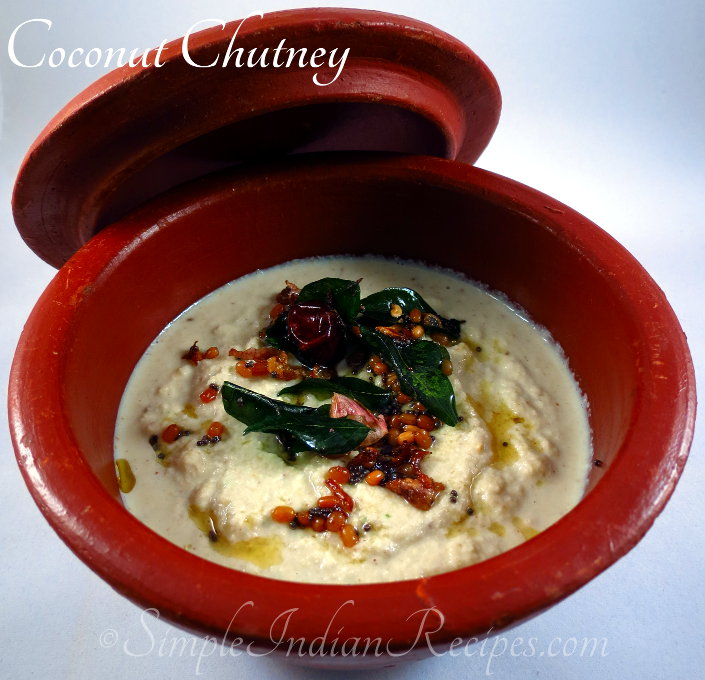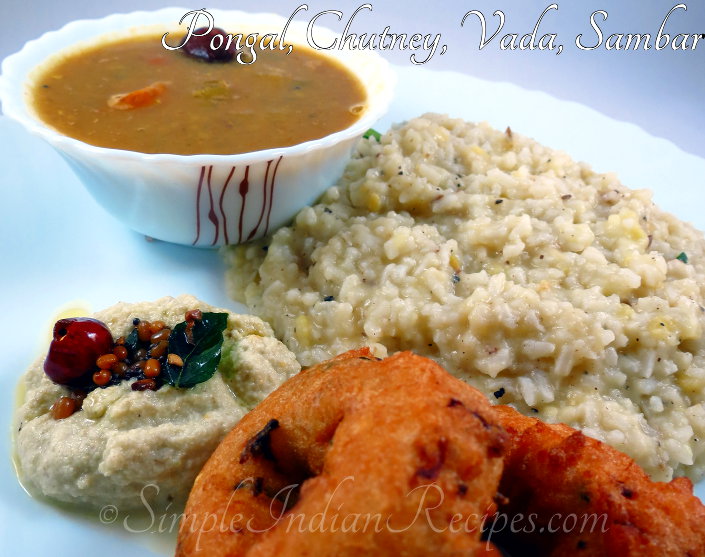- Submitted by Dahlia
(Thengai Chutney, Nariyal Ki Chutney, White Coconut Chutney)

Name any South Indian tiffin item; it is always accompanied with pure white, creamy coconut chutney blessed with crisp curry leaves, mustard seeds and red chilies. Coconut chutney is probably one of the many reasons why many of us love to eat dosa and idly. Coconut chutney is very easy to make and can be made in a jiffy. It can be made within the short time, the idlis are steamed or the dosa are getting roasted for the extra crispness.
Coconut chutney or Thengai Chutney is made in different forms depending on the tiffin item they are served with. For idly and dosa, chutney is made a slightly watery so it can be dipped in and relished. For dishes like vada, bajji and bondas, chutney is made thick (getti chutney) with just sufficient water to grind. Coconut chutney is also made in umpteen varieties, some of which I have mentioned in the variations below. Each of them depends on the region they belong to and there is a slight variation in ingredients used. Below is the recipe of the basic coconut chutney that can be served with idly, dosa or ven pongal.
Video Instructions for making White Coconut Chutney
Recipe for Basic Coconut Chutney
Preparation time: 5 minutes
Cooking time: 1 minute (for tempering)
Serves: 4-6
Ingredients
For Chutney
- Grated Coconut (preferably fresh) - 1 cup
- Dalia (Roasted channa dal, pottu kadalai) - 1/4 cup
- Green Chilies - 3 (or as needed)
- Ginger - a small piece (blueberry size)
- Salt - as needed
For Tempering
- Oil - 1 tsp (preferably coconut oil)
- Mustard seeds - 1/4 tsp
- Urad dal - 1 tsp (optional)
- Curry Leaves - 1 strand
- Dry red chilies- 2 (broken)

Method
- Grind all the ingredients under 'For Chutney' with little warm drinking water. Add water as per the thickness of the chutney needed.
- Heat oil in a pan and splutter the mustard seeds, urad dal curry leaves and dry red chilies.
- Transfer the ground chutney to the serving bowl and add the tempering to it. Mix it together and serve.
Tips
- Use freshly broken (or grated) coconut for making chutney as it tastes the best. If the coconut is little tender, it tastes even better. For people living abroad, try your best to use fresh coconut. If you do not have access to it, then you have to manage with frozen or unsweetened shredded coconut.
- Use hot or warm water while grinding the chutney to make it smoother. Also, we do not cook the chutney. So be sure to use pure drinking water while grinding the chutney.
- Some people prefer the pure white chutney for which 2 ladles of warm milk can be added while grinding the chutney.
- Tempering with coconut oil gives additional aroma to the chutney.
Serving Coconut Chutney
- Serve the coconut chutney with idli, dosa, vada, bajji, upma, pongal etc.
- Coconut chutney goes very well with pretty much every south Indian breakfast dishes.
Variations
As mentioned earlier many variations can be made in coconut chutney. Some of it is:-
- Addition of a small piece of tamarind gives a tangy taste to the chutney. This tangy coconut chutney tastes very well with rawa upma.
- You could also add 2-3 pods of garlic to get a unique flavor and taste. This variety can be a best accompaniment to adai or pesarattu.
- Red coconut chutney: Replace the green chilies with red chilies in the same recipe. It is very aromatic and tasty. The red chilies can be soaked in water for 5 minutes prior for easy grinding.
- Coriander coconut chutney (also called Green Coconut Chutney or Kothamalli chutney) : To the basic recipe ingredients, add ¼ cup cleaned chopped coriander leaves and grind the same. This chutney can be used as a spread in sandwiches and chapatti rolls.

Other Chutney Recipes